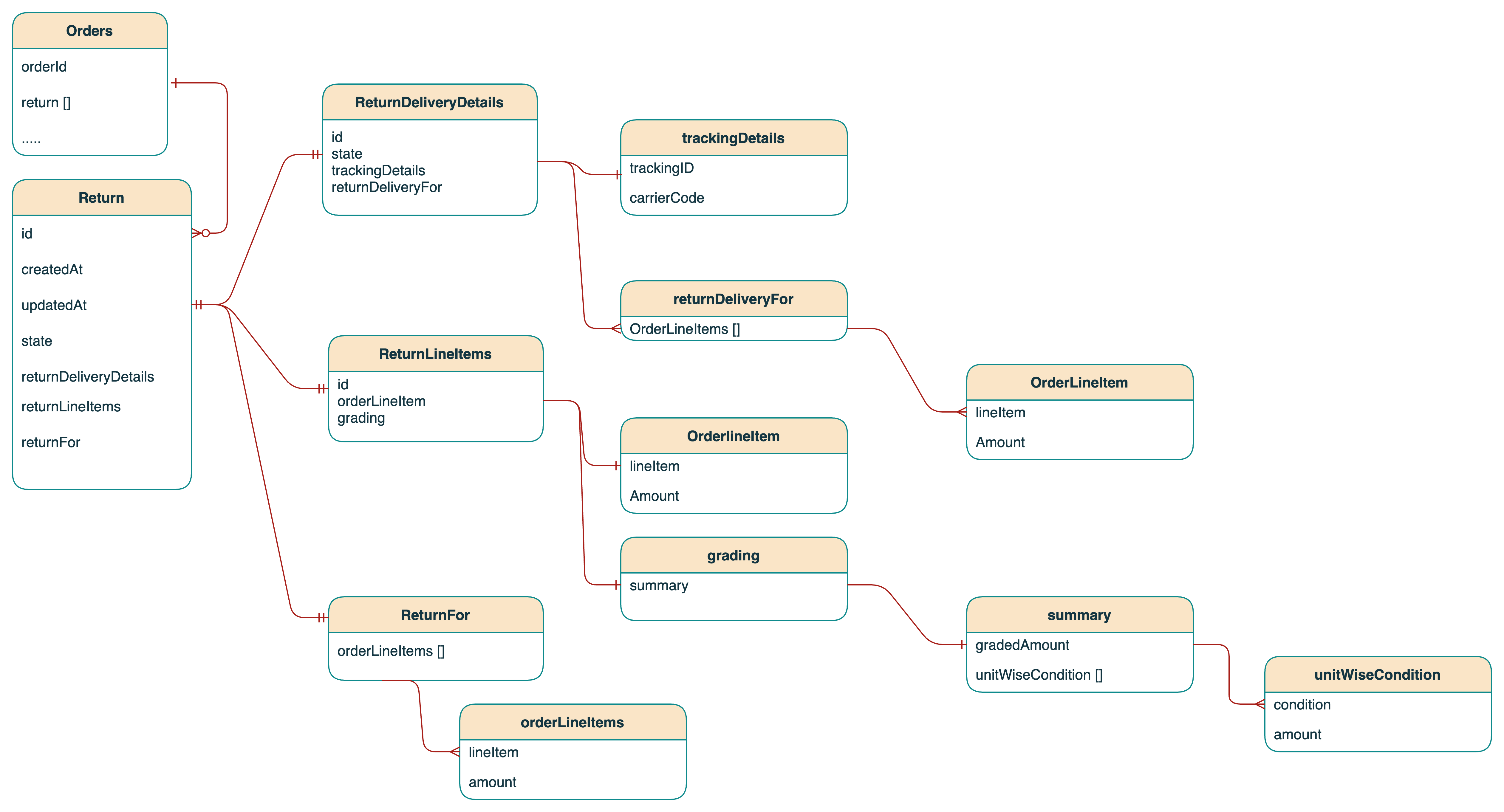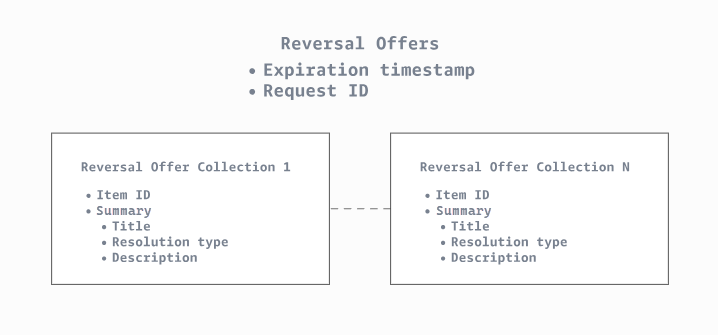Return Interface
Buy with Prime API is now available for early access
Sign up for early access to the Buy with Prime API using the 'Sign Up' button below. The API may change as Amazon receives feedback and iterates on it.
A Buy with Prime return is an action that a customer takes to return previously-delivered items that they purchased in a Buy with Prime order.
This topic outlines terminology and Buy with Prime API operations that you use to manage Buy with Prime returns.
Terminology
The following sections describe terminology related to returns.
Return
A Buy with Prime return is an action that a customer takes to return previously-delivered items that they purchased in a Buy with Prime order.
Currently, you can create Buy with Prime returns for eligible items only within the Buy with Prime merchant console, and customers can create returns within the online returns center.
If you subscribe to Buy with Prime return events, you're notified of returns by event types that start with RETURN, such as the RETURN_STARTED event, RETURN_COMPLETED event, and so on. For details about what to do when you receive one of these events, see Steps to Process Returns.
When you process returns, you call the order query for more information about the return. The response provides information such as return status updates, return item details, return creation time, and so on. This information helps you understand the overall return process and status. The following image shows the fields of the order query response that are pertinent to returns. (Click the image to enlarge it.)

Order query response fields related to returns
Refund
A Buy with Prime refund is a process by which a customer is reimbursed for an item that they ordered, which is then returned or cancelled. A return always leads to a refund.
For details, see Refund Interface.
Buy with Prime returns lifecycle
Throughout the shopper journey, customers interact with returns in the following ways.
Buy with Prime Shopper Journey for a Return
- Pre-checkout: As a customer browses products on your site, the site (product detail page, search page, and so on) shows whether a Buy with Prime item is eligible for return. You provide this information by getting a reversal offer.
- Checkout: On your site's checkout pages, the customer sees whether each of the Buy with Prime items in the order is eligible for a return. As with pre-checkout, you provide this information by getting a reversal offer.
- Post-order: After the customer places the order and the Buy with Prime items are delivered to the customer, the customer can check the shopper order detail page to see whether each of the Buy with Prime items in the order is eligible for return along with a deadline for the return.
- Return creation: You or the customer creates a return for return-eligible Buy with Prime items in an order within the return window. Currently, you can create Buy with Prime returns only within the Buy with Prime merchant console, and customers can create returns within the online returns center. Returns can only be created for Buy with Prime items that have been delivered to the customer.
- Return: The customer drops off the item according to their chosen return transportation method, and the item is then shipped and returned to an Amazon fulfillment center. To handle returns, see Steps to Process Returns.
- Refund: Every Buy with Prime return is associated with a refund. You issue a refund to the customer when you are notified by the
REFUND_REQUESTEDevent. To handle refunds, see Steps to Process Refunds.
Relationship between orders and returns
A Buy with Prime order with only one item can have only one associated return. However, a Buy with Prime order with multiple items or multiple quantities of the same item can be associated with multiple returns as follows:
- You or the customer can create different returns for each item separately.
- You or the customer can create different returns with partial quantities of the same item.
- You or the customer can create different returns for different items at different points in time.
For example, consider an order in which two units of item A and one unit of item B were delivered. The customer might create the following two returns:
- Return 1 with the first unit of item A
- Return 2 with the second unit of item A and one unit of item B
The following example shows a response to a query to get the details of the order.
{
"data": {
"order": {
"id": "example-order-id",
"returns": {
"details": [
{
"id": "example-return-id-1",
"createdAt": "2022-02-03T18:17:19Z",
"updatedAt": "2022-02-03T18:17:19Z",
"state": "CREATED",
"returnFor": {
"returnOrderLineItems": [
{
"lineItem": {
"id": "example-line-item-id-1"
},
"returnedQuantity": {
"amount": 1
}
}
]
}
},
{
"id": "example-return-id-2",
"createdAt": "2022-02-04T18:17:19Z",
"updatedAt": "2022-02-04T18:17:19Z",
"state": "CREATED",
"returnFor": {
"returnOrderLineItems": [
{
"lineItem": {
"id": "example-line-item-id-1"
},
"returnedQuantity": {
"amount": 1
}
},
{
"lineItem": {
"id": "example-line-item-id-2"
},
"returnedQuantity": {
"amount": 1
}
}
]
}
}
]
}
}
}
}
Reversal
Reversal is a term that the Buy with Prime API uses to encompass the concepts of returns, refunds, and cancellations.
Reversal offer
At a high level, a Buy with Prime reversal offer specifies whether the item (or multiple items that are bought together) can be returned by evaluating a set of conditions specified in the returns policy found at About Our Returns Policies, which you must follow and incorporate into your existing policies. A reversal offer contains the following information (some of which is nested inside the reversal offer object):
id: The unique identifier of the reversal offers response.expiresAt: The timestamp by which the reversal offers expire.reversalOfferCollection: A list of items and associated reversal offers. Each item in the list contains the item ID and its associated reversal offers. Each reversal offer has anitemand asummary.summary: A title and a description string that you can display to shoppers on the product detail page, the checkout page, and so on. The summary contains return eligibility (returnable/non-returnable) and a return window (for example, 30 days from order delivery). The summary also contains resolution types likeRETURN, which indicates the return eligibility of the item. An absence of theRETURNresolution means that the item is not eligible for return. You can use these resolutions to display custom messages or UI elements.

API operations
The Buy with Prime Return interface and Order interface support the following mutations, queries, and events related to the Buy with Prime return lifecycle.
The following figure shows the role of mutations, queries, and events in the Buy with Prime return lifecycle. (Click the image to enlarge it.)

API calls and events in the Buy with Prime Return Lifecycle
Mutations
None.
Queries
| Name | Description |
|---|---|
reversalOffers | Provides a reversal offer for a given Buy with Prime product. For examples, see Get Reversal Offers. |
order | Gets a Buy with Prime order, in which you can see the returns associated with an order. With this information, you can update the return details in your order management system. For more information, see Get Return Details and Steps to Process Returns. |
Events
| Event | When Event is Published |
|---|---|
RETURN_COMPLETED | Represents that a Buy with Prime return that was initiated earlier was successfully completed. |
RETURN_DELIVERY_COMPLETED | Represents that a returned Buy with Prime item was delivered to the fulfillment center. |
RETURN_DELIVERY_FAILED | Represents that a returned Buy with Prime item failed to be delivered to the fulfillment center. |
RETURN_DELIVERY_IN_TRANSIT | Represents that a returned Buy with Prime item was dropped off at the carrier location. |
RETURN_ITEM_GRADED | Represents that the grading of a returned Buy with Prime item at the fulfillment center is complete. |
RETURN_STARTED | Represents that a return of one or more purchased Buy with Prime items was successfully initiated. |
Related topics
Updated 20 days ago
